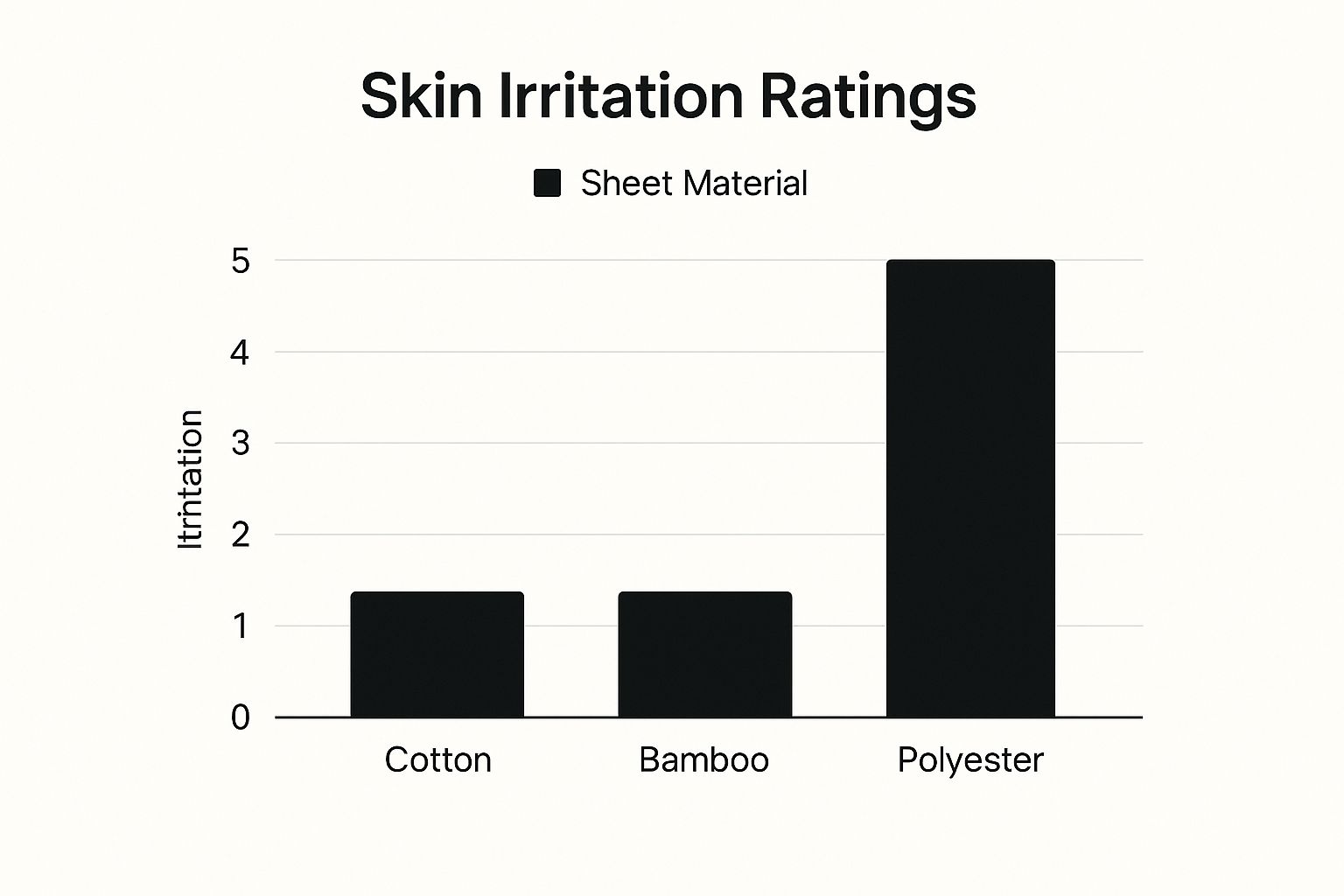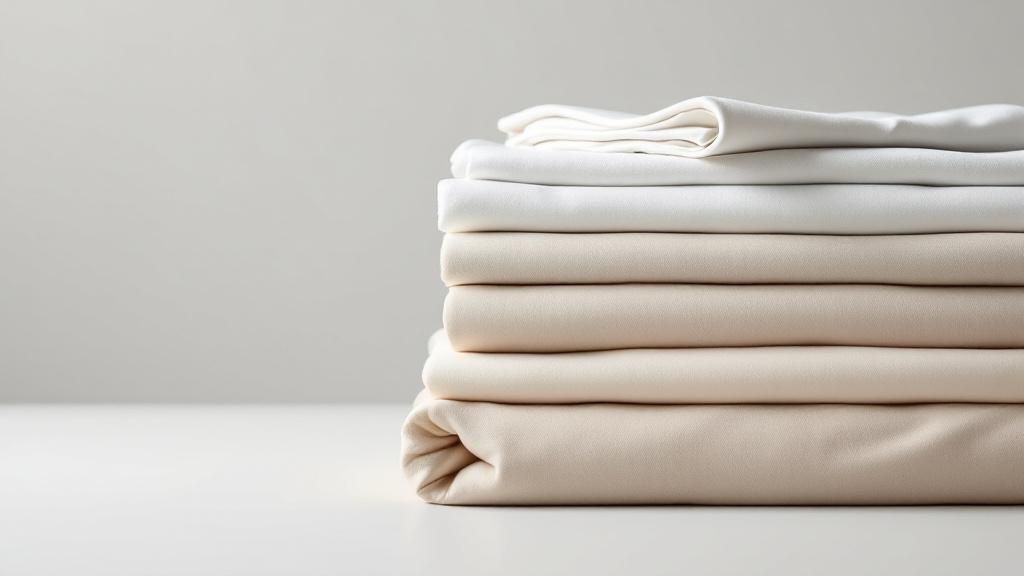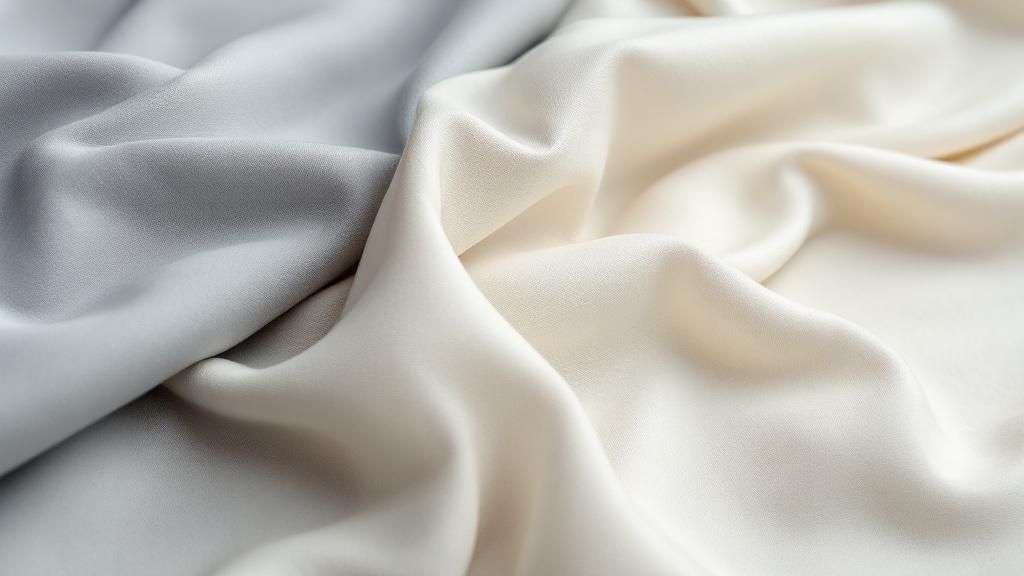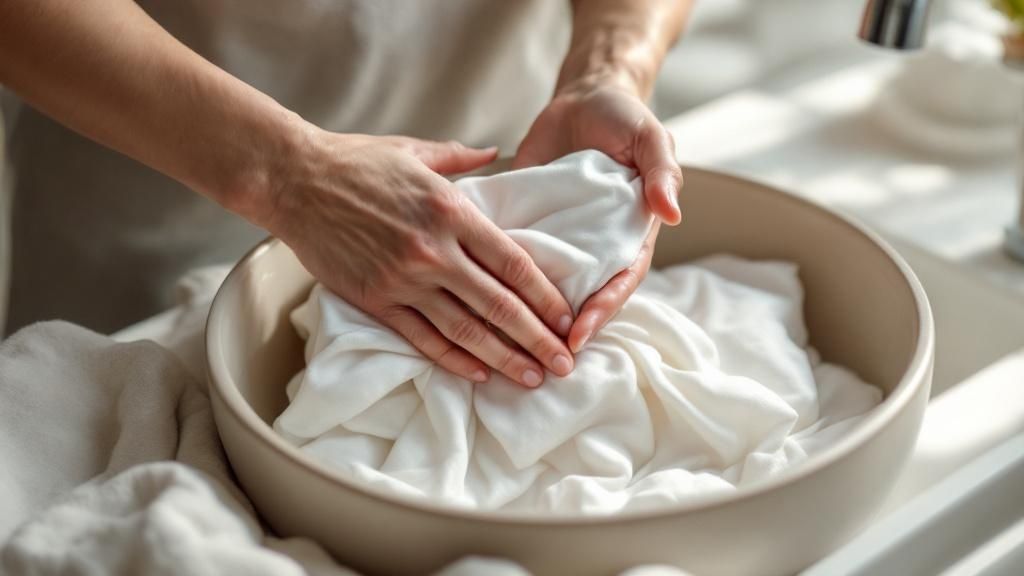If you have eczema, you already know that nighttime can feel like a constant battle against the urge to scratch. But what if I told you your bed sheets could be your secret weapon in this fight? It's true—your bedding is so much more than just a decorative touch. It's an essential part of managing your skin's health.
The wrong kind of fabric can trap heat and sweat right against your skin, basically creating a perfect storm for irritation and flare-ups. On top of that, common allergens like dust mites just love to make their home in certain materials. When your skin barrier is already compromised by eczema, it's particularly susceptible to these triggers.
How the Right Fabric Can Soothe Your Skin
Think of choosing the right sheets as taking a proactive step toward a more healing, restorative night's sleep. Smooth, breathable fabrics allow air to flow freely, which is crucial for preventing the overheating and sweating that so often lead to intense itching.
This is where the difference between materials really becomes clear.

As you can see, natural fibers like bamboo and cotton are significantly kinder to sensitive skin than synthetic materials like polyester. It's a pretty stark difference.
Your sheets are in direct contact with your skin for around eight hours every single night. Investing in the right ones can genuinely reduce irritation and give your skin a better chance to heal.
This isn't just a niche concern anymore. The global eczema market, valued at approximately USD 17.81 billion in 2025, is expected to climb to USD 24.35 billion by 2029. This boom is driven by a growing demand for products that offer real relief, including specialized bedding. You can read more about these eczema market trends to see how consumer needs are pushing the industry forward.
Quick Guide to Eczema-Friendly Sheet Fabrics
Navigating the world of bedding can be overwhelming, so I've put together this quick comparison to help you spot the best (and worst) options for sensitive skin.
| Fabric Type | Key Benefit for Eczema | Potential Drawback |
|---|---|---|
| 100% Bamboo Viscose | Exceptionally soft, temperature-regulating, and moisture-wicking. | Can be pricier and requires gentle washing. |
| Tencel™ Lyocell | Silky-smooth texture that reduces friction; very breathable. | Higher price point compared to cotton. |
| Organic Cotton | Soft, breathable, and widely available. Gets softer with each wash. | Can be less smooth than bamboo or Tencel. |
| Silk | Naturally hypoallergenic and extremely smooth on the skin. | Expensive and has very specific care needs. |
| Polyester/Microfiber | Inexpensive and durable. | Not breathable; traps heat and moisture. |
| Wool/Flannel | Warm and cozy for cold nights. | Can feel rough or "scratchy," causing irritation. |
Ultimately, fabrics like bamboo, Tencel, and high-quality organic cotton are your best bets. They offer the breathability and smoothness that eczema-prone skin desperately needs to stay calm and comfortable through the night.
The Best Fabric Choices for Soothing Sensitive Skin

When you're trying to find the best sheets for eczema, the material is everything. The right fabric can actively soothe your skin and help break that frustrating itch-scratch cycle. Get it wrong, and you're in for a long, uncomfortable night.
Let's walk through the top contenders that can turn your bed into a true sanctuary for sensitive skin.
Tencel: The Silky Smooth Operator
You may have heard of Tencel, a brand name for a type of fabric called lyocell. It's usually made from sustainably sourced eucalyptus wood pulp, and its biggest win for eczema sufferers is its incredibly smooth fiber surface. Think about it: rough fabrics create friction, which is the last thing irritated skin needs. Tencel simply glides over your skin, minimizing that physical aggravation while you sleep.
It's also a master of moisture management. Tencel pulls moisture away from the body and releases it, which helps prevent the damp, clammy feeling that can trigger flare-ups. Keeping your skin cool and dry is half the battle.
Bamboo: The Natural Cooler
Bamboo fabric, particularly viscose from bamboo, has a lot in common with Tencel. It's famous for being exceptionally soft—people often compare it to high-thread-count cotton or even silk, but without all the fussy maintenance. That gentle touch is a massive relief when your skin barrier is already compromised.
Where bamboo really shines is its natural thermoregulating ability. It helps you stay cool when it's hot and warm when it's chilly, preventing the overheating and night sweats that often lead to intense itching. This makes it a fantastic year-round choice. If you want to learn more, we have a complete guide to the benefits of bamboo sheets that goes into more detail.
Cotton: The Classic Comfort
Now, not all cotton is the same, and for eczema-prone skin, the specific type of cotton is crucial. You can't just grab any set off the shelf.
Here’s what to look for:
- Long-staple cotton: Varieties like Pima or Egyptian cotton have longer fibers. This creates a fabric that's smoother, more durable, and far less likely to feel abrasive against your skin.
- Organic cotton: This is a big one. It means the cotton was grown without the harsh pesticides and chemicals that can leave behind irritating residues.
- Sateen weave: This weaving pattern puts more threads on the surface, which gives the fabric a silkier, smoother feel compared to a crisp percale. For reducing friction, sateen is usually the better bet.
Microfiber: The Budget-Friendly Alternative
If you're working with a tighter budget, a high-quality microfiber sheet set can be a good option. Made from finely woven synthetic fibers like polyester, microfiber is naturally hypoallergenic and resistant to dust mites—two major triggers for people with both allergies and eczema.
The main trade-off here is breathability. Compared to natural fibers like bamboo or Tencel, microfiber can sometimes trap heat. If you're a hot sleeper, this could be a deal-breaker. It's really a balance between affordability and top-tier performance.
How to Read Labels and Choose Wisely

Walking into the bedding aisle can feel like information overload. Packages boast about high thread counts and Egyptian cotton, but when you're managing eczema, the real story is always in the fine print. Learning to decode those labels is your best tool for finding sheets that soothe, not irritate.
The first thing I always look for is a specific certification. Honestly, it's a non-negotiable for sensitive skin.
The OEKO-TEX Standard 100 certification is your best friend. This label is a guarantee that every single component of the product—from the fabric to the thread and even the zipper—has been tested and found free of a long list of harmful substances known to aggravate a compromised skin barrier.
If a set of sheets has that label, you can breathe a little easier knowing you're avoiding a whole host of potential irritants like harsh dyes and chemical finishes. It's the quickest way to filter out the bad stuff right from the start.
Look Past the Thread Count Hype
We’ve all been conditioned to think that a higher thread count equals better sheets. But for eczema, that's not always the case. In fact, a super-high thread count can create a dense fabric that doesn't breathe well, trapping heat and moisture against your skin—a perfect recipe for a flare-up.
Instead of getting hung up on that number, shift your focus to the details that truly matter for comfort and skin health:
-
Fabric Weave: A sateen weave typically feels silkier and glides over the skin, which can help reduce friction. On the other hand, a percale weave is often crisper, lighter, and more breathable, making it a great choice if you tend to overheat. Think about your main trigger: is it rough textures or getting too warm at night?
-
Keywords: When you're shopping online, use search terms that point to cleaner products. Look for sheets described as "unbleached," "dye-free," or made with "plant-based dyes." This minimizes your skin's contact with common chemical irritants.
-
Color Choice: While it's not a foolproof rule, lighter-colored sheets generally involve less dye. If your skin is extremely sensitive, sticking with white, off-white, or natural, un-dyed shades is often the safest bet.
Washing Your Sheets for Maximum Comfort
Choosing the right sheets for eczema is a great start, but how you wash them is just as important for keeping your skin happy. The wrong laundry habits can turn your cozy sanctuary into an irritation zone, undoing all the good your specialty sheets are meant to do.
It all starts with your detergent. My advice is to always reach for a gentle, liquid, fragrance-free detergent. Powdered versions can sometimes leave behind a fine, gritty residue that feels like sandpaper on an already sensitive skin barrier. And fragrances? They're one of the most notorious triggers for eczema flare-ups, so it's best to avoid them entirely.
You’ll also want to ditch the fabric softeners and dryer sheets for good. These products achieve that "soft" feel by coating the fabric fibers with a waxy chemical film. That residue is not only a major potential skin irritant but also clogs the pores of your breathable sheets, making them less effective at wicking moisture.
Nailing Your Wash Routine
I've found that washing sheets once a week is the sweet spot. Sticking to a regular schedule is key because it stops the buildup of sweat, dead skin cells, and allergens like dust mites, which absolutely love to make a home in our bedding.
Here are a few more pro-tips for an eczema-friendly wash cycle:
- Go Hot: Wash your sheets in warm or hot water. While cold water is often recommended to preserve fabric, higher temperatures are far more effective at killing off dust mites—a common and potent eczema trigger.
- Add an Extra Rinse: If your washing machine has an extra rinse setting, use it. This is a simple but powerful trick to make sure every last trace of detergent is washed away before the fabric touches your skin.
- Low and Slow Drying: Tumble dry your sheets on a low heat setting. High heat can be really harsh on delicate fibers like bamboo or Tencel, breaking them down over time and making them feel less soft.
A consistent, gentle washing routine is non-negotiable. It keeps your sheets free of irritants and protects the very fabric that's meant to be protecting your skin.
For a deeper dive into caring for bamboo specifically, check out our guide on how to care for your bamboo sheets. Following those steps will help you get the absolute most life and softness out of them.
What Fabrics and Features Should You Steer Clear Of?

Knowing what to look for is only half the battle. Just as important is knowing what to avoid, because certain materials and features can actively work against your skin, turning your bed into an irritation zone rather than a safe haven.
Some fabrics are immediate red flags for anyone with sensitive skin. Wool and flannel, for example, might seem cozy, but their rough texture can cause physical irritation on an already fragile skin barrier. The same goes for many low-quality synthetic blends like polyester, which simply don't breathe. They trap heat and sweat right against your skin, creating a humid, itchy environment that's a recipe for a flare-up.
Don't Overlook Hidden Irritants in Bedding
It’s not always about the fabric itself. Sometimes, the real culprits are the hidden chemical treatments and decorative details. You should be especially skeptical of sheets labeled "wrinkle-free" or "permanent press." That convenience usually comes from a chemical finish containing formaldehyde, a notorious skin irritant known to aggravate eczema.
Even the little things can make a big difference for sensitive skin. Think about:
- Rough Embroidery: That beautiful decorative stitching can feel like sandpaper against inflamed skin.
- Lace Trim: While it looks lovely, lace often has a surprisingly abrasive edge.
- Harsh Dyes: Bright, deeply saturated colors can require more aggressive chemical processing, which increases the potential for irritation.
Your goal should be to create the smoothest, most neutral environment you possibly can. Anything that can physically rub or chemically irritate your skin is a potential trigger, no matter how small it seems.
The growing demand for products that meet these needs is undeniable. The global eczema market, valued at USD 18.1 billion in 2024, is expected to surge past USD 40 billion by 2035. This growth is largely driven by a demand for supportive care items, including specialized bedding. You can discover more insights about eczema market growth to see how the industry is shifting toward safer, more skin-friendly solutions.
Your Questions About Eczema Sheets Answered
Even when you’ve done your homework, picking the perfect sheets for eczema-prone skin can still feel a bit tricky. Let's walk through some of the common questions people have, so you can feel confident you're creating the best possible environment for a peaceful night's sleep.
Are Silk Sheets a Good Choice for Eczema?
I get this question a lot. On the surface, silk seems like a perfect match—it’s incredibly smooth and glides across irritated skin without causing friction. That part is true, and it's a huge plus.
The catch, however, is performance. Silk isn't the most breathable fabric and doesn't pull moisture away from your body nearly as well as bamboo or Tencel. If you're prone to night sweats, that trapped moisture can become a real problem. It’s also expensive and requires very delicate care. While silk can work, you'll often find that bamboo gives you that same luxurious smoothness but with far better temperature and moisture control.
How Often Should I Replace My Sheets with Eczema?
There's no hard-and-fast rule here, but for someone with eczema, the texture of your sheets is everything. The constant washing, especially in hot water needed to eliminate dust mites, inevitably breaks down fibers over time.
The best advice I can give is to pay close attention to how your sheets feel. The moment they start to feel even slightly rough, pilled, or less slick against your skin, it’s time for a new set. As a general benchmark, plan on investing in high-quality sheets every 2-3 years. Owning at least two sets and rotating them can also significantly extend their lifespan.
Can the Right Sheets Actually Cure My Eczema?
This is a critical point, and it’s important to set the right expectations. Great sheets are a powerful tool for managing your eczema, but they are not a cure.
Eczema is a complex medical condition. Your bedding is just one piece of a much bigger puzzle that involves your skincare routine, medical treatments, and avoiding personal triggers. Think of eczema-friendly sheets as your best defense against nightly irritation. They create a soothing environment that supports your skin's natural healing process and, just as importantly, helps you get the restorative sleep you need.
By choosing fabrics that don't make your condition worse, you're taking a huge step in the right direction. For a deeper dive, take a look at our guide to the best sheets for sensitive skin.
Ready to transform your sleep into a soothing experience? The 100% organic bamboo sheets from Bamtek are OEKO-TEX certified, hypoallergenic, and designed to be incredibly gentle on even the most sensitive skin.










